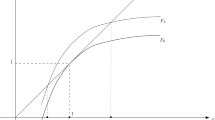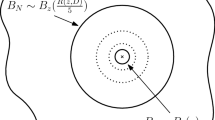Abstract
In this paper, we complete and provide details for the existing characterizations of the decimation of the Ising model on \(\mathbb{Z}^{2}\) in the generalized Gibbs context. We first recall a few features of the Dobrushin program of restoration of Gibbsianness and present the construction of global specifications consistent with the extremal decimated measures. We use them to prove that these renormalized measures are almost Gibbsian at any temperature and to analyse in detail its convex set of DLR measures. We also recall the weakly Gibbsian description and complete it using a potential that admits a quenched correlation decay, i.e. a well-defined configuration-dependent length beyond which this potential decays exponentially. We use these results to incorporate these decimated measures in the new framework of parsimonious random fields that has been recently developed to investigate probability aspects related to neurosciences.
Similar content being viewed by others
Notes
We briefly write μ[f] for the expectation \(\mathbb{E}_{\mu}[f]\) of a measurable function f under a measure μ.
Taken as definition of consistency by Kozlov [24].
One mostly reserves the terminology “phase” to the t.i. extremal elements of \(\mathcal{G}(\gamma)\).
More precisely, the set \(\mathcal{G}(\gamma)\) is even a non-empty compact convex subset of \(\mathcal{M}_{1}^{+}\) [17].
Tail-measurability is required to insure that the partition function is well-defined.
Such a potential is also called a lattice-gas potential, see e.g. the terminology of [23].
They prove that there exists disjoint sets Ω +,Ω −⊂Ω such that ν +(Ω +)=ν −(Ω −)=1 and a translation invariant interaction Φ with Ω Φ =Ω +∪Ω − such that ν + and ν − are weakly Gibbs for the pair (Φ,Ω Φ ). In their framework ν + and ν − share the same interaction but concentrate on different configurations.
In general, and in particular in our set-up, this set is always a Choquet simplex, i.s. a convex set where each element is determined by a unique convex combination of the extremal elements, see e.g. [17, 28]. Moreover, these extreme points are the DLR measures that are trivial on the tail σ-algebra \(\mathcal{F}_{\infty}\).
Consider e.g. a path that essentially avoids all contours of the configuration [33].
It is known that at β c the correlations decay sub-exponentially according to a power law, while typical exponentially decaying scenarii for the behavior of the systems in certain regimes are studied in [45].
One sometimes speaks about a constrained or hidden phase transitions.
This set has been originally introduced in [3] to get correlation estimates for the +-phase.
The conditioning acts as an external field h 2i =+1 on the even sites, known to lead to uniqueness with the +-phase as an equilibrium state.
A similar construction can be done for any γ monotonicity-preserving and right- or left-continuous.
One says that the configuration is frozen in ω on S c.
See e.g. [12], p. 1304 or proceed like in pp. 1294–1295.
The freezing acts as an all positive/negative magnetic field, for which uniqueness holds from Theorem 1.
A more complete variational principle has been established in [25], but we do not need it here.
A complete interpretation and characterization in the original Gibbsian context can be also found in [23].
Consistent with a t.i. UAC potential. It does not imply its existence for t.i. quasilocal measure, because the potential built by Kozlov from a t.i. quasilocal specification is not necessarily translation invariant [25].
Introduced by Pfister [37] to state general large deviation principles.
See e.g. [53], p. 970 for a one-line proof.
To be true, this re-writing requires absolute convergence, checked next section.
See e.g. Proposition 4.24 in [11]. Here, we have even more because the specification is right-continuous.
This is not the case if one removes the condition k≤i.
References
Aizenman, M.: Translation-invariance and instability of phase coexistence in the two-dimensional Ising system. Commun. Math. Phys. 73(1), 83–94 (1980)
Bricmont, J., Kupiainen, A., Lefevere, R.: Renormalization group pathologies and the definition of Gibbs states. Commun. Math. Phys. 194(2), 359–388 (1998)
Burton, R.M., Steif, J.E.: Quite weak Bernoulli with exponential rate and percolation for random fields. Stoch. Proc. Appl. 58(35) (1995)
Cassandro, M., Galves, A., Löcherbach, E.: Partially observed Markov random fields are variable neighborhood random fields. J. Stat. Phys. 174(4), 795–807 (2012)
Coquille, L., Velenik, Y.: A finite-volume version of Aizenman-Higuchi theorem for the 2d-Ising model. Probab. Theory Relat. Fields 153, 25–44 (2012)
Dobrushin, R.L.: The description of a random field by means of conditional probabilities and conditions of its regularity. Theory Probab. Appl. 13, 197–224 (1968)
Dobrushin, R.L.: A Gibbsian representation for non-Gibbsian fields. In: Workshop ‘Probability and Physics’, Renkum (1995)
Dobrushin, R.L., Shlosman, S.B.: Large and moderate deviation in the Ising model. In: Probability Contributions of Statistical Mechanics. Advances in Soviet Mathematics, vol. 20, pp. 91–221. AMS, Providence (1991)
Dobrushin, R.L., Shlosman, S.B.: “Non-Gibbsian” states and their Gibbs description. Commun. Math. Phys. 200(1), 125–179 (1999)
Dynkin, E.B.: Sufficient statistics and extreme points. Ann. Probab. 6(5), 705–730 (1978)
Fernández, R.: Gibbsianness and non-Gibbsianness in lattice random fields. In: Bovier, A., van Enter, A.C.D., den Hollander, F., Dunlop, F. (eds.) Mathematical Statistical Physics. Proceedings of the 83rd Les Houches Summer School, July 2005. Elsevier, Amsterdam (2006)
Fernández, R., Pfister, C.-E.: Global specifications and non-quasilocality of projections of Gibbs measures. Ann. Probab. 25(3), 1284–1315 (1997)
Fernández, R., Le Ny, A., Redig, F.: Variational principle and almost quasilocality for renormalized measures. J. Stat. Phys. 111(1/2), 465–478 (2003)
Föllmer, H.: Phase transition and Martin boundary In: Séminaires de Probabilités IX, Université de Strasbourg. Lecture Notes in Mathematics, vol. 465, pp. 305–317. Springer, Berlin (1975)
Föllmer, H.: On the global Markov property. In: Streit, L. (ed.) Quantum Fields: Algebras, Processes, pp. 293–302. Springer, New York (1980)
Galves, A., Löcherbach, E.: Stochastic chains with memory of variable length. In: Festschrift in Honour of the 75th Birthday of Jorma Rissanen. Tampere University Press, Tampere (2008)
Georgii, H.O.: In: Gibbs Measures and Phase Transitions. De Gruyter Studies in Mathematics, vol. 9. De Gruyter, Berlin (1988). See also, 2nd edn. (2011)
Goldstein, S.: A note on specifications. Z. Wahrscheinlichkeitstheor. Verw. Geb. 46, 45–51 (1978)
Goldstein, S.: Remarks on the global Markov property. Commun. Math. Phys. 74 (1980)
Griffiths, R.B.: Peierls proof of spontaneous magnetization in a two-dimensional Ising ferromagnet. Phys. Rev. (2) 136(136), A437–A439 (1964)
Higuchi, Y.: On the absence of non-translation-invariant Gibbs states for the two-dimensional Ising model. In: Random Fields, Esztergom, 1979, vol. II, pp. 517–534 (1981)
Ising, E.: Beitrag sur Theorie des Ferromagnetismes. Z. Phys. 31, 253–258 (1925)
Israel, R.B.: Convexity in the Theory of Lattice Gases. Princeton University Press, Princeton (1979)
Kozlov, O.: Gibbs description of a system of random variables. Probl. Inf. Transm. 10, 258–265 (1974)
Külske, C., Le Ny, A., Redig, F.: Relative entropy and variational properties of generalized Gibbsian measures. Ann. Probab. 32(2), 1691–1726 (2004)
Lanford, O.E., Ruelle, D.: Observables at infinity and states with short range correlations in statistical mechanics. Commun. Math. Phys. 13, 194–215 (1969)
Le Ny, A.: Decimation on the two-dimensional Ising model: non-Gibbsianness at low temperature. almost Gibbsianness or weak Gibbsianness? In: Fascicule de Probabilités, Rennes, 1998. Publ. Inst. Rech. Math. Rennes (1998). 71 pp.
Le Ny, A.: Introduction to generalized Gibbs measures. Ens. Mat. 15 (2008)
Lefevere, R.: Variational principle for some renormalized measures. J. Stat. Phys. 96(1–2), 109–133 (1999)
Löcherbach, E., Orlandi, E.: Neighborhood radius estimation for variable-neighborhood random fields. Stoch. Process. Appl. 121(9), 2151–2185 (2011)
Lörinczi, J., Maes, C., Vande Velde, K.: Transformations of Gibbs measures. Probab. Theory Relat. Fields 112, 121–147 (1998)
Maes, C., Vande Velde, K.: Relative energies for non-Gibbsian states. Commun. Math. Phys. 189, 277–286 (1997)
Maes, C., Redig, F., Shlosman, S., Van, A., Percolation, M.: Path large deviations and weak Gibbsianity. Commun. Math. Phys. 209(8), 517–545 (1999)
Maes, C., Redig, F., Van Moffaert, A.: Almost Gibbsian versus weakly Gibbsian. Stoch. Process. Appl. 79(1), 1–15 (1999)
Maes, C., Redig, F., Van Moffaert, A.: The restriction of the Ising model to a layer. J. Stat. Phys. 94, 893–912 (1999)
Peierls, R.B.: On Ising’s model of ferromagnetism. Proc. Camb. Philos. Soc. 32 (1936)
Pfister, C.-E.: Thermodynamical aspects of classical lattice systems. In: In and Out of Equilibrium. Probability with a Physical Flavor. Progress in Probability, pp. 393–472 (2002)
Pirogov, S.A., Sinai, Y.G.: Phase diagrams for classical lattice systems. Theor. Math. Phys. 25, 1185–1192 (1976)
Pirogov, S.A., Sinai, Y.G.: Phase diagrams for classical lattice systems. Theor. Math. Phys. 26, 39–49 (1976)
Preston, C.: Random Fields. Lectures Notes in Mathematics, vol. 534. Springer, Berlin (1976)
Preston, C.: Construction of specifications. In: Streit, L. (ed.) Quantum Fields—Algebras, Processes. Bielefeld Symposium, 1978, pp. 269–282. Springer, Wien (1980)
Rissanen, J.: A universal data compression system. IEEE Trans. Inf. Theory 29, 656–664 (1983)
Russo, L.: The infinite cluster method in the two-dimensional Ising model. Commun. Math. Phys. 67(3), 251–266 (1979)
Schonmann, R.H.: Projections of Gibbs measures may be non-Gibbsian. Commun. Math. Phys. 124, 1–7 (1989)
Schonmann, R.H., Shlosman, S.B.: Complete analyticity for 2D Ising completed. Commun. Math. Phys. 170, 453–482 (1995)
Shlosman, S.B.: Path large deviation and other typical properties of the low-temperature models, applications to weakly Gibbs states. Markov Process. Relat. Fields 6, 121–133 (2000)
Sinai, Y.G.: Theory of Phase Transition: Rigorous Results. Pergamon, Oxford (1982)
Sokal, A.D.: Existence of compatible families of proper regular conditional probabilities. Z. Wahrscheinlichkeitstheor. Verw. Geb. 56, 537–548 (1981)
Sullivan, W.G.: Potentials for almost Markovian random fields. Commun. Math. Phys. 33, 61–74 (1976)
Syozi, I.: Transformations of Ising models. In: Domb, C., Green, M.S. (eds.) Phase Transitions and Critical Phenomena, vol. 1. Academic Press, New York (1972)
van Enter, A.C.D., Shlosman, S.B.: (Almost) Gibbsian description of the sign fields of SOS fields. J. Stat. Phys. 92(3/4), 353–368 (1998)
van Enter, A.C.D., Verbitskiy, E.A.: On the variational principle for generalized Gibbs measures. Markov Process. Relat. Fields 10, 411–434 (2004)
van Enter, A.C.D., Fernández, R., Sokal, A.D.: Regularity properties and pathologies of position-space R.G. transformations: scope and limitations of Gibbsian theory. J. Stat. Phys. 72, 879–1167 (1993)
Author information
Authors and Affiliations
Corresponding author
Additional information
A. Le Ny is on leave from Université de Paris-Sud, Laboratoire de Mathématiques d’Orsay (LMO UMR CNRS 8628).
Work supported by the ANR project ANR-JCJC-0139-RANDYMECA.
Rights and permissions
About this article
Cite this article
Le Ny, A. Almost Gibbsianness and Parsimonious Description of the Decimated 2d-Ising Model. J Stat Phys 152, 305–335 (2013). https://doi.org/10.1007/s10955-013-0773-1
Received:
Accepted:
Published:
Issue Date:
DOI: https://doi.org/10.1007/s10955-013-0773-1




